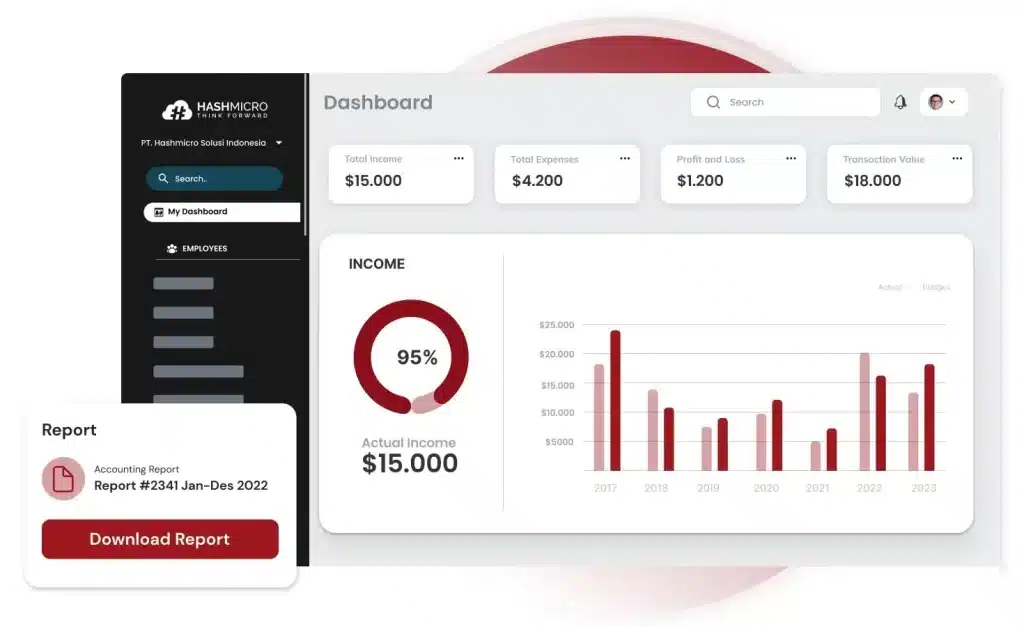Many SaaS companies face significant challenges when it comes to accurately calculating Monthly Recurring Revenue (MRR), a crucial metric for business growth. Surprisingly, common mistakes like including one-time payments or free trial users often distort the actual recurring revenue picture.
This is especially true for startups, where miscalculations often stem from counting the full value of annual or quarterly subscriptions upfront rather than spreading them across months.
Even though MRR isn’t governed by strict accounting standards like IFRS, getting it wrong can mislead investors and give businesses a false sense of security. The result? Misjudged financial health, poor growth strategies, and a potential wake-up call when momentum stalls
This article will discuss the strategies to avoid these common mistakes by explaining what monthly recurring revenue (MRR) is, why it’s important for business, and how to correctly calculate it.
Key Takeaways
|
What is Monthly Recurring Revenue?
Monthly Recurring Revenue (MRR) is the predictable and consistent total revenue generated by a business from all active subscriptions on a monthly basis.
This metric, commonly used by subscription and SaaS companies, normalizes various pricing plans and billing periods into a single figure, allowing businesses to track revenue trends over time.
MRR includes recurring charges from discounts, coupons, and add-ons but excludes one-time fees. It is essential for assessing a company’s current financial health, forecasting future revenue, and making informed strategic decisions.
Difference between Monthly Recurring Revenue and Accounting Revenue
When tracking revenue, it’s essential to use the correct terms and understand their meanings. A key distinction is between accounting revenue and MRR.
Monthly Recurring Revenue (MRR) focuses on the predictable income your business generates on a monthly basis. On the other hand, accounting revenue follows standardized rules that ensure companies report their total earnings consistently and transparently, offering a full and accurate financial picture.
What are the Types of Monthly Recurring Revenue?

MRR links customers to their accounts, which illustrates their subscription behavior. A rise in MRR reflects more customer acquisitions, upgrades, or both, while a drop points to downgrades, cancellations, or churn.
To understand these shifts, you must track the factors affecting MRR separately. Breaking MRR into specific types gives deeper insights into revenue, customer behavior, and overall business health.
1. New MRR
New MRR refers to the additional monthly revenue generated from acquiring new customers within a specific month.
Example: If your business secures 5 new subscriptions at $500 each per month, the New MRR would be 5 × $500 = $2,500.
2. Upgrade MRR
Upgrade MRR is the extra monthly revenue obtained when existing customers move to higher-priced plans during a month. This calculation also includes any additional add-ons they purchase.
Example: If a customer upgrades from a $50/month plan to a $200/month plan and adds a $25/month add-on, the Upgrade MRR would be ($200 – $50) + $25 = $175.
3. Downgrade MRR
Downgrade MRR represents the decrease in monthly revenue when customers switch to lower-priced plans within a month.
Example: If a customer downgrades from a $500/month plan to a $100/month plan, the Downgrade MRR would be $500 – $100 = $400.
4. Expansion MRR
Expansion MRR is the additional monthly revenue generated from existing customers through add-ons, upselling, or cross-selling compared to the previous month. Positive Expansion MRR indicates successful customer retention and increased revenue without incurring Customer Acquisition Costs (CAC).
Growth Rate Example:
If your MRR at the start of the month is $800K and you gain $17K in Expansion MRR during the month, the Expansion MRR growth rate is ($17K / $800K) × 100 = 2.1%.
5. Reactivation MRR
Reactivation MRR is the monthly revenue brought in by customers who previously churned but have returned to a paid subscription plan.
Example: If 5 churned customers reactivate their subscriptions at $50/month each, the Reactivation MRR is 5 × $50 = $250.
6. Contraction MRR
Contraction MRR denotes the loss in monthly revenue due to actions like subscription cancellations, downgrades, pauses, credits, discounts, or the removal of add-ons within a month. Unlike Downgrade MRR, it encompasses various factors leading to revenue reduction.
Example: Offering a $30 discount to 50 long-term customers results in a Contraction MRR of 50 × $30 = $1,500.
7. Churn MRR
Churn MRR is the total monthly revenue lost from customers who cancel their subscriptions within a specific month.
Example: If 3 customers each paying $1,000/month cancel their subscriptions, the Churn MRR is 3 × $1,000 = $3,000.
8. Net New MRR
Net New MRR measures the overall change in monthly recurring revenue for the current month compared to the previous month. It is calculated using the formula:
Net New MRR = New MRR + Expansion MRR – Churn MRR
A positive Net New MRR indicates revenue growth, while a negative value signifies a decline.
Example:
- New MRR: 5 new customers × $100/month = $500
- Expansion MRR: 10 upgrades × ($200 – $100) = $1,000
- Churn MRR: 3 churned customers × $200/month = $600
- Net New MRR = $500 + $1,000 – $600 = $900
For practical examples and case studies, you can also read our article on real-world applications of the retention ratio.
Why is Tracking MRR Important?

MRR gives insights that assist you in deciding what steps to take to build your business by providing a realistic picture of your company’s revenue potential. Let’s look into what MRR can provide that makes it an important subscription metric:
1. Tracking performance
MRR provides a monthly snapshot of your company’s financial health, which is important for assessing growth in a subscription business. It also helps ensure consistent cash flow, thereby keeping the business on a sustainable path.
For example, if your MRR has steadily increased by 5% each month for the past six months, you can confidently adjust your goals for the upcoming quarter.
2. Revenue forecasting
MRR offers accurate revenue estimates for the near future. By examining your monthly performance, you can forecast how much income you will create the following month and make changes as needed.
For instance, if your MRR is $120,000 in January, and you expect a 10% growth rate, you can forecast around $132,000 for February, guiding your sales team’s efforts accordingly.
3. Budgeting
MRR lets you plan spending based on predictable monthly revenue, which gives you more control over resource allocation.
For example, if your MRR increases by $15,000 but your new customer sign-ups are decreasing, you might decide to allocate more budget to marketing initiatives to attract new customers.
4. Measuring growth and momentum
If you’re aiming for rapid business growth or have investors backing you, tracking your MRR growth every month is crucial. MRR is a key sign of how fast your business is growing.
The month-to-month increase in MRR will clearly show whether your business is taking off, gaining new customers and revenue, or if you’re still in the early stages of growth.
What is a Good MRR Rate?
Benchmarking MRR can be challenging since performance depends on the market, customer demographics, and business stage. Here are a few useful guidelines to consider:
1. Growth Based on ARR:
- For ARR below $2.5 million, a growth rate of 100% or more is typically targeted.
- As companies move into the $5-15 million ARR range, they should aim for a 40-55% MRR growth rate annually.
- At $25-75 million ARR, the growth rate generally stabilizes around 30-40%.
- For those with ARR over $75 million, a more modest 20-30% growth rate is often seen.
2. ARPU Benchmarks:
- With ARPU under $15K, you should expect around a 40-50% MRR growth rate.
- ARPU between $25-100K sees growth rates in the range of 30-40%.
- Companies with ARPU over $250K generally see 20-30% MRR growth annually.
3. Marketing Spend Impact:
- Companies that spend less than 20% of their revenue on marketing should see around 20-25% MRR growth.
- Those spending 40-60% may target 30% growth, while more aggressive spenders, allocating over 60% of revenue to marketing, can see up to 60-70% MRR growth.
4. Sales Channels Influence:
- Online sales generally deliver around 45-50% MRR growth, while field sales are slower, around 30%.
- Third-party channels and affiliates can drive higher growth, up to 50-55%.
These benchmarks reflect the focus on efficiency and growth seen in businesses today, particularly in markets like Singapore, where tech adoption is high and companies strive for scalable growth.
Common Mistakes When Calculating Monthly Recurring Revenue

MRR is a key metric for subscription businesses, but there are some common mistakes that business owners should avoid to ensure accurate calculations.
1. Counting full value of long-term contracts in a single month
When a customer pays upfront for a longer subscription, the total value should be divided by the subscription length when calculating MRR. The goal of MRR is to measure growth and momentum, not cash flow.
Including the full value upfront can distort important metrics like customer churn rate and customer lifetime value. The only time you should count the full amount is when calculating bookings.
2. Deducting transaction fees and delinquent charges
While it may seem logical to subtract transaction fees and delinquent charges to get a more conservative figure, this leads to inaccurate results. Delinquent charges fall in a gray area between active and churned customers, especially if failed payments are usually recovered.
Instead of deducting these from MRR, categorize them separately to better track lost revenue. Similarly, transaction fees should not be subtracted as they can be optimized over time. Label them as an expense rather than reducing MRR.
3. Including one-time payments
One-time sales or payments shouldn’t be part of MRR, as they are not recurring. Including them inflates your revenue expectations and distorts your financial model since these payments don’t occur regularly.
4. Adding trial users
One major mistake is counting trial users and their potential future value in MRR before they officially become paying customers. This inflates the number of “new” and “churned” customers, as trials do not have a 100% conversion rate.
5. Excluding discounts
Another error is neglecting to account for discounts in your MRR. If a customer receives a discount on a $100/month plan and only pays $50, your MRR is $50, not $100.
Failing to include discounts gives an inaccurate picture of your actual revenue, and once the discount is removed, your MRR will adjust accordingly.
These mistakes can be avoided by using smart technology, such as an advanced accounting system that helps identify and calculate revenue sources accurately as part of a strong revenue strategy. Click the banner below to learn more.

How to Calculate Monthly Recurring Revenue
The easiest way to calculate MRR is by multiplying your Average Revenue per User (ARPU) on a monthly basis by the total number of active users for that month.
The formula for calculating MRR:
Monthly ARPU x Total Monthly Users = Monthly Recurring Revenue
Let’s break it down further with these four steps:
- Organize your data
Start by gathering all customer data for the month and placing it into a spreadsheet. Include a unique identifier for each customer in one column (like an account ID), and in the next column, list their subscription value. If there are multi-month contracts, divide the total value of the contract by the number of months to get the monthly rate. - Calculate total MRR
Sum up the subscription values in the spreadsheet. The total of this column will be your Monthly Recurring Revenue for that month. - Segment by cohort
While it’s helpful to see the total MRR, breaking it down by pricing plans or customer segments provides more insights. Use the same method but only include the data from the specific cohort or plan you’re analyzing. - Measure MRR growth
After calculating your total MRR, it’s important to track MRR growth. To do this, categorize MRR into segments like “New MRR”, “Add-on MRR”, and “Churn MRR”. Use the following formula to calculate growth:
(New MRR + Add-on MRR) – Churn MRR = Growth MRR
For example, say you have 12 customers on your Basic plan paying $20 per month and 8 customers on your Premium plan paying $40 per month. Your total MRR would be (12 x $20) + (8 x $40) = $560.
Of course, MRR calculations can get more complex as you dive into key metrics like expansion MRR (upgrades), churn, downgrades, and new customers. For example, if existing customers upgrade, you’ll want to factor that in alongside your customer churn to get a fuller picture.
Tips to Increase Monthly Recurring Revenue

To grow your Monthly Recurring Revenue (MRR), it’s important to focus on key business strategies. By enhancing customer satisfaction and optimizing your offerings, you can boost recurring revenue consistently.
Here are some effective tips to help you increase your MRR and drive sustainable growth.
1. Reinforce the value of your product
Minimizing churn is critical for sustaining MRR growth. While some churn is unavoidable, reminding customers of your product’s value can help retain those on the verge of leaving.
To do this, focus on delivering excellent customer service, regular product improvements, and clear communication of key benefits. Regularly reinforcing how your product addresses customer needs can significantly reduce churn and boost customer loyalty.
2. Optimize your pricing strategy
Pricing isn’t one-size-fits-all, and adjusting it requires continuous testing. Conduct regular A/B tests and market research to find the right price point for different customer segments.
Offering tiered pricing plans—such as basic, standard, and premium—can attract a wider range of customers while maximizing revenue
3. Make it easy for customers to scale
Allowing customers to seamlessly upgrade or increase their usage encourages them to spend more.
Implement tiered pricing models where customers can easily access additional services or features by moving to higher plans or using consumption-based pricing to let them scale according to their needs.
4. Identify and target upsell opportunities
Sometimes, the biggest growth potential comes from existing customers. Analyze your customer base to identify accounts with the potential for higher spending. Look at usage patterns and compare them with the customer’s overall spending power.
For high-value clients, personalized offers or direct outreach may be more effective than automated upgrade flows. These tailored approaches can unlock significant revenue by upselling or expanding their use of your product.
5. Ensure accurate MRR calculations
Accurate MRR tracking is vital for making informed decisions. Avoid common mistakes like including one-time payments, trial accounts, or subtracting fees and delinquent charges from MRR.
Keep your calculations focused only on recurring revenue to ensure you’re measuring growth correctly. This will give you a clearer view of your financial performance and help guide your strategies for scaling revenue.
6. Utilize an accounting system for precise MRR tracking
While it’s important to focus on growth strategies, having an accurate accounting system in place is equally critical for managing your MRR effectively.
Automated best accounting software helps track recurring revenue seamlessly, ensuring every transaction—from subscriptions to upgrades—is recorded with precision. Beyond simple bookkeeping, it provides instant clarity on your financial health and customer engagement.
Calculate and Track Your Monthly Recurring Revenue with Accounting Software

Keeping track of recurring revenue can feel like an uphill battle, especially when juggling multiple subscriptions, payments, and financial reports. All of these must have been frustrating and risky for your business.
However, keeping track of your MRR and all of its components can be made easy with HashMicro Accounting Software. It takes the stress out of managing MRR by automating the entire process, from reconciliation to payment scheduling and real-time financial tracking.
With powerful, easy-to-use features, you’ll gain full control over your revenue streams confidently. Moreover, HashMicro Accounting Software is also equipped with powerful AI and BI to provide accurate, real-time insight into your revenues.
Here are some of the most useful features of this accounting software:
- Bank Integration – Auto Reconciliation: Automatically syncs bank transactions with internal records to ensure every cent of your MRR is accounted for.
- Bank Integration – Auto Payment: Never miss a payment again with automated processing for all scheduled transactions.
- Profit & Loss vs Budget & Forecast: Stay on top of your financial goals by comparing actual results with forecasts in real-time.
- Cash Flow Reports: Get a clear view of your cash flow to ensure consistent, healthy liquidity from your recurring revenue.
- Financial Statement with Budget Comparison: Measure performance by comparing your current revenue against your planned targets.
- Forecast Budget: Plan for future growth by predicting revenue trends and aligning your resources accordingly.
Conclusion
Monthly Recurring Revenue (MRR) is the predictable income a business generates from all active subscriptions. It allows businesses to monitor revenue trends, forecast future earnings, and make strategic financial decisions confidently. Accurate MRR tracking is vital for subscription-based companies seeking long-term growth and sustainability.
With HashMicro Accounting Software, managing your MRR becomes a breeze. It automates everything from reconciliation to payment scheduling. Gain real-time insights into your revenue so you can focus on growing your business without worries!
Not only does HashMicro Accounting Software give you control over your financial health, but it also grows with your business. With AI capabilities, it provides accurate forecasts, helping you plan for the future like a pro.
Try the free demo today, and see how much easier managing your MRR can be; confirm power one!
Warning: Undefined array key "med" in /home/hashmicr/public_html/blog/wp-content/plugins/insert-headers-and-footers/includes/class-wpcode-snippet-execute.php(419) : eval()'d code on line 281

FAQ About Monthly Recurring Revenue
-
What is MRR and ARR?
Monthly Recurring Revenue (MRR) is likely the most vital metric for a SaaS business. Its counterpart, Annual Recurring Revenue (ARR)—sometimes referred to as the Annualized Run Rate—relates closely but carries key distinctions.
-
What is KPI monthly recurring revenue?
MRR is closely tied to other essential key performance indicators like Annual Recurring Revenue (ARR), Customer Lifetime Value (CLV), and Customer Acquisition Cost (CAC). A strong MRR generally reflects a high CLV, demonstrating that a company’s marketing strategies effectively retain its customers.
-
What is a good recurring revenue percentage?
Industry experts consider a 10-20% Net MRR growth rate as healthy. By minimizing churn, boosting upsells, and offering cross-sells and add-ons, businesses can achieve their ideal MRR growth rate.
-
What is the monthly recurring revenue benchmark?
The most widely used MRR metric is the MRR Growth Rate, which tracks the yearly increase in MRR. As one of the top growth metrics for SaaS companies, it is influenced by two primary factors: the target customer market and the company’s size.






























